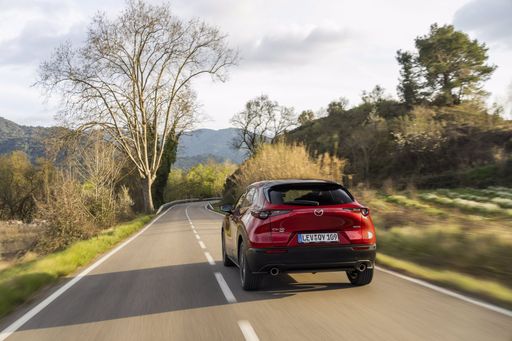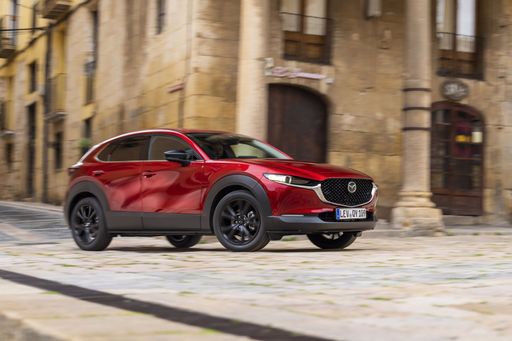As the SUV market continues to expand, two vehicles that have captured attention for their unique offerings are the Mazda CX-30 and the SsangYong Torres. Both models boast distinct characteristics that cater to different consumer needs. In this article, we’ll dive deeper into the technical aspects and innovative features of these two remarkable SUVs.
Mazda CX-30 vs SsangYong Torres – Differences & prices compared
Both models have their strengths – but which one suits you more?
Compare performance, efficiency, price and space directly: Mazda CX-30 or SsangYong Torres?
Design and Dimensions
The Mazda CX-30 showcases a sleek and modern design, standing at 4395 mm in length, 1795 mm in width, and 1540 mm in height. This compact SUV promotes a feeling of agility while still providing sufficient passenger space. It features a stylish five-door layout and can comfortably seat five occupants.
In contrast, the SsangYong Torres is larger, measuring 4700 mm in length, 1890 mm in width, and 1710 mm in height. This considerable size translates to a more robust presence on the road. With a spacious five-door design, the Torres offers ample room for both passengers and cargo.
Engine Performance
Under the hood, the Mazda CX-30 is available in two petrol MHEV engine options delivering a robust power output of 140 to 186 HP. This SUV delivers a balance of performance and efficiency, with acceleration from 0 to 100 km/h ranging from 8.3 seconds to 10.3 seconds. The engine options come paired with either a manual or an automatic transmission and offer front-wheel or all-wheel drive configurations.
The SsangYong Torres, on the other hand, also offers a versatile engine lineup. Customers can choose from petrol and electric options, with power ranging from 163 to 207 HP. Notably, the electric variant boasts an impressive electric range of 462 km, making it appealing for eco-conscious drivers. Torques reach up to 339 Nm, providing a strong pull, particularly beneficial for off-road adventures. Like the CX-30, it also offers both manual and automatic transmissions with front-wheel or all-wheel drive capabilities.
Fuel Efficiency and Consumption
When it comes to fuel efficiency, the Mazda CX-30 edges out slightly with a consumption range of 5.7 to 6.6 L/100km, showcasing Mazda’s commitment to creating more efficient engines. The CO2 emissions also reflect positively, ranging from 129 to 148 g/km.
The SsangYong Torres, however, has a consumption rating of 7.9 to 9.1 L/100km for its petrol engines, while its electric model offers a unique metric of 18.7 kWh/100km. The Torres reflects a CO2 efficiency class from G (for petrol) to A (for electric), underlining its potential for zero emissions travel.
Interior and Technology
Inside the Mazda CX-30, drivers will find a premium cabin with high-quality materials and the latest infotainment technology. The vehicle features a trunk capacity of 430 liters, sufficient for daily needs. A range of driver-assistance technologies enhances the driving experience, making it both enjoyable and safe.
The SsangYong Torres aims at offering a more spacious interior with a trunk capacity of 703 liters, providing excellent utility for families or individuals needing extra cargo space. It also comes equipped with modern infotainment features and safety technologies to ensure a connected and secure driving environment.
Conclusion
Ultimately, the Mazda CX-30 and SsangYong Torres are both excellent choices within the SUV segment, each tailored for different types of consumers. The CX-30 is a refined, efficient option for those who value fuel economy and stylish design. In contrast, the Torres offers a larger footprint with innovative electric options, making it a compelling choice for families and eco-conscious drivers alike. The decision between these two vehicles will largely come down to personal priorities, be it efficiency, size, or innovative features.
Here’s where it gets real: The technical differences in detail
Costs and Efficiency:
Looking at overall running costs, both models reveal some interesting differences in everyday economy.
Mazda CX-30 has a clearly perceptible advantage in terms of price – it starts at 25200 £, while the SsangYong Torres costs 33800 £. That’s a price difference of around 8614 £.
Fuel consumption also shows a difference: Mazda CX-30 manages with 5.70 L and is therefore noticeable more efficient than the SsangYong Torres with 7.90 L. The difference is about 2.20 L per 100 km.
Engine and Performance:
Power, torque and acceleration are the classic benchmarks for car enthusiasts – and here, some clear differences start to show.
When it comes to engine power, the SsangYong Torres has a a bit edge – offering 207 HP compared to 186 HP. That’s roughly 21 HP more horsepower.
In terms of top speed, the Mazda CX-30 performs minimal better – reaching 204 km/h, while the SsangYong Torres tops out at 194 km/h. The difference is around 10 km/h.
There’s also a difference in torque: SsangYong Torres pulls distinct stronger with 339 Nm compared to 240 Nm. That’s about 99 Nm difference.
Space and Everyday Use:
Whether family car or daily driver – which one offers more room, flexibility and comfort?
Both vehicles offer seating for 5 people.
In curb weight, Mazda CX-30 is slight lighter – 1455 kg compared to 1498 kg. The difference is around 43 kg.
In terms of boot space, the SsangYong Torres offers distinct more room – 703 L compared to 430 L. That’s a difference of about 273 L.
In maximum load capacity, the SsangYong Torres performs to a small extent better – up to 1662 L, which is about 256 L more than the Mazda CX-30.
When it comes to payload, SsangYong Torres slightly takes the win – 552 kg compared to 496 kg. That’s a difference of about 56 kg.
Who comes out on top?
Overall, the Mazda CX-30 shows itself to be won narrowly and secures the title of DriveDuel Champion.
It convinces with the more balanced overall package and proves to be the more versatile choice for everyday use.

Mazda CX-30
Mazda CX-30
The Mazda CX-30 effortlessly combines sleek design with a sense of adventure, making it an appealing choice for urban explorers and countryside enthusiasts alike. Inside, the cabin is thoughtfully designed, offering both comfort and cutting-edge technology to enhance the driving experience. Its performance on the road is agile, providing a smooth and engaging journey for drivers and passengers.
details @ de.mazda-press.com
@ de.mazda-press.com
 @ de.mazda-press.com
@ de.mazda-press.com
 @ de.mazda-press.com
@ de.mazda-press.com
 @ de.mazda-press.com
@ de.mazda-press.com
SsangYong Torres
The SsangYong Torres stands out with its rugged design and robust stance, ideal for adventure enthusiasts seeking a reliable companion for off-road escapades. Inside, the vehicle offers a spacious and comfortable cabin equipped with modern features to enhance the driving experience. Its performance is geared towards delivering a smooth ride, making it versatile for both city driving and rural trails.
details

|
|
|
|
|
Costs and Consumption |
|
|---|---|
|
Price
25200 - 36800 £
|
Price
33800 - 44600 £
|
|
Consumption L/100km
5.7 - 6.6 L
|
Consumption L/100km
7.9 - 9.1 L
|
|
Consumption kWh/100km
-
|
Consumption kWh/100km
18.70 kWh
|
|
Electric Range
-
|
Electric Range
462 km
|
|
Battery Capacity
-
|
Battery Capacity
-
|
|
co2
129 - 148 g/km
|
co2
0 - 207 g/km
|
|
Fuel tank capacity
48 - 51 L
|
Fuel tank capacity
50 L
|
Dimensions and Body |
|
|---|---|
|
Body Type
SUV
|
Body Type
SUV
|
|
Seats
5
|
Seats
5
|
|
Doors
5
|
Doors
5
|
|
Curb weight
1455 - 1587 kg
|
Curb weight
1498 - 1618 kg
|
|
Trunk capacity
422 - 430 L
|
Trunk capacity
703 L
|
|
Length
4395 mm
|
Length
4700 mm
|
|
Width
1795 mm
|
Width
1890 mm
|
|
Height
1540 mm
|
Height
1710 mm
|
|
Max trunk capacity
1398 - 1406 L
|
Max trunk capacity
1662 L
|
|
Payload
458 - 496 kg
|
Payload
552 kg
|
Engine and Performance |
|
|---|---|
|
Engine Type
Petrol MHEV
|
Engine Type
Petrol, Electric
|
|
Transmission
Manuel, Automatic
|
Transmission
Manuel, Automatic
|
|
Transmission Detail
Manual Gearbox, Automatic Gearbox
|
Transmission Detail
Manual Gearbox, Automatic Gearbox, Reduction Gearbox
|
|
Drive Type
Front-Wheel Drive, All-Wheel Drive
|
Drive Type
Front-Wheel Drive, All-Wheel Drive
|
|
Power HP
140 - 186 HP
|
Power HP
163 - 207 HP
|
|
Acceleration 0-100km/h
8.3 - 10.3 s
|
Acceleration 0-100km/h
-
|
|
Max Speed
191 - 204 km/h
|
Max Speed
191 - 194 km/h
|
|
Torque
238 - 240 Nm
|
Torque
280 - 339 Nm
|
|
Number of Cylinders
4
|
Number of Cylinders
4
|
|
Power kW
103 - 137 kW
|
Power kW
120 - 152 kW
|
|
Engine capacity
1998 - 2488 cm3
|
Engine capacity
1497 cm3
|
General |
|
|---|---|
|
Model Year
2025
|
Model Year
2023 - 2024
|
|
CO2 Efficiency Class
D, E
|
CO2 Efficiency Class
G, A
|
|
Brand
Mazda
|
Brand
SsangYong
|
What drive types are available for the Mazda CX-30?
The Mazda CX-30 is offered with Front-Wheel Drive or All-Wheel Drive.
The prices and data displayed are estimates based on German list prices and may vary by country. This information is not legally binding.
